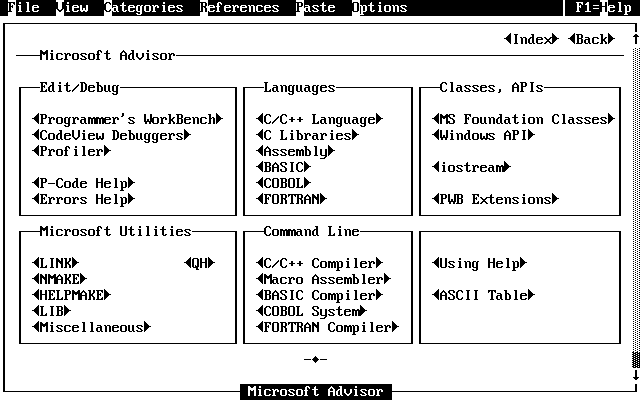 At the operating-system command line, type:
At the operating-system command line, type:You can also run QuickHelp from the MS-DOS command line or by double-clicking the QuickHelp - Microsoft Advisor icon in the Windows Program Manager.
·To get Help on the LIB utility:
 At the operating-system command line, type:
At the operating-system command line, type:
QH LIB.EXE
You can type the name of any Microsoft utility instead of LIB.
·To start QuickHelp to view the Advisor Contents screen:
 At the operating-system command line, type:
At the operating-system command line, type:
QH Advisor
In addition to information about programs, QuickHelp can also display information about compiler and run-time errors. Type QH and the error number with its alphabetic prefix on the command line.
Opening and Closing Help Files
When you run QuickHelp, it looks for the environment variable HELPFILES and opens all listed .HLP files. If the HELPFILES variable isn't defined, QuickHelp opens all .HLP files in directories specified by the PATH environment variable.
Warning:
Windows Help files are not compatible with QuickHelp. Make sure that Windows Help files are not listed in the HELPFILES environment variable.
Choose the List Database command on the File menu to view a list of all the open Help files.
·To open additional Help files:
 Choose the Open Database command from the File menu.
Choose the Open Database command from the File menu.
 Type the name of the Help file to be opened in the dialog box that appears. You can specify all Help files in a directory by typing *.HLP.
Type the name of the Help file to be opened in the dialog box that appears. You can specify all Help files in a directory by typing *.HLP.
 Press ENTER or click the OK button with the left mouse button.
Press ENTER or click the OK button with the left mouse button.
·To close an open Help file:
1.Choose the Close Database command from the File menu.
The File menu changes to a list of open Help files.
2.Choose the Help file to close.
You can view information about a topic by using the Search command on the View menu. When topic information is displayed, it is shown in the same format as information presented by the Microsoft Advisor.
·To display a topic from any of the open Help files:
1.Choose the Search command from the View menu.
2.Type the topic you want information about in the dialog box.
3.Click the OK button or press ENTER.
QuickHelp searches for the topic in the open Help files. If the topic cannot be found, a dialog box informs you that the search failed. If the search is successful, information about the topic is displayed in the QuickHelp window.
A series of commands on the View menu allow you to display selected topics. These commands include the following:
| Command | Description |
| View History | Displays a list of all the topics that have recently been displayed. See “Using Topic Lists” for information on using the list. |
| View Last | Displays the last topic you looked at. |
| View Next | Displays the next topic in the Help file. |
| View Back | Moves backward one topic in the Help file. |
The QuickHelp window shown in Figure 23.6 is similar to the Microsoft Advisor Help window. Information that doesn't fully fit in a window can be scrolled, and hyperlinks are used to display additional information. The main difference is that information presented in QuickHelp cannot be copied selectively.

Copying and Pasting in QuickHelp
To transfer information from QuickHelp to another program, specify a file with the Rename Paste File command in the File menu. Once the file is specified, choose the Current Window or the Current Topic command in the Paste menu to transfer the text to that file. Be sure to specify a new file when you paste because QuickHelp overwrites the existing file by default. To append to an existing file, choose the Paste Mode command from the Options menu. The default filename is PASTE.QH in the directory specified by the TMP environment variable.
In addition to the features mentioned previously, QuickHelp has a variety of other options such as changing the appearance of the Help window, searching for text within topics, and controlling the function of the right mouse button.
·To learn more about QuickHelp's features:
1.Make sure the QH.HLP file is open.
2.To view QuickHelp's Help, press F1. -or-To get information about a menu command, click it with the right mouse button, or highlight the command and press F1.